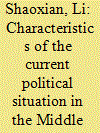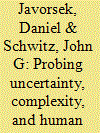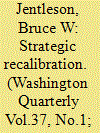|
|
|
Sort Order |
|
|
|
Items / Page
|
|
|
|
|
|
|
| Srl | Item |
| 1 |
ID:
130607


|
|
|
|
|
| Publication |
2014.
|
| Summary/Abstract |
By comparison with the "Arab Spring" that swept through the whole Bregion in 2011 and the political transition evident in many Arab countries in 2012, political development in the Middle East in 2013, to many observers, seemed lost in chaos. Arab countries undergoing political change were plagued by disorder, volatility, and violence. With US. strategic withdrawal from the region imminent, geopolitical dynamics
regrouped. Struggles among regional powers entered a new stage. Four characteristics of the Middle East situation are harbingers for future outcomes: political "ehaos" in the Arab world, "flux and reflux" between moderate and radical lslamists, geopolitical shocks caused by the strategic withdrawal of the U.S. from the region, and continued uncertainty over the Iranian nuclear issue.
|
|
|
|
|
|
|
|
|
|
|
|
|
|
|
|
| 2 |
ID:
193454


|
|
|
|
|
| Summary/Abstract |
India promotes connectivity at a high level through its Look East policy, Connect Central Asia, the Asia-Africa Growth Corridor, and free trade agreements and alliances. However, problems with infrastructure, especially in the Northeast and Myanmar, are proving to be obstacles to these endeavors.Recognizing the importance of regional infrastructure, Japan and the EU approach China’s objectives with caution.
|
|
|
|
|
|
|
|
|
|
|
|
|
|
|
|
| 3 |
ID:
175386


|
|
|
|
|
| Summary/Abstract |
The entire globe seems to be reeling under a pathogenic threat, a global contagion is doing the rounds, has been the buzzword. But, the news of India-China border confrontation at Galwan Valley in Mid June 2020 has also been grabbing headlines and created a volatile situation in Ladakh Valley.
|
|
|
|
|
|
|
|
|
|
|
|
|
|
|
|
| 4 |
ID:
133415


|
|
|
|
|
| Publication |
2014.
|
| Summary/Abstract |
Geopolitical dynamics associated with nuclear proliferation, the Arab Spring, the rapid rise of Chinese power, an oil-fueled Russian resurgence, and the post-Afghan and Iraq eras will demand significant changes in intelligence focus, processes, and resources. Nearly a decade after intelligence failures required a restructuring of the Intelligence Community with mandates for a scientific approach to intelligence analysis, current efforts continue to focus on overly deterministic individual analyst methods. We argue for a process-oriented approach to analysis resembling the collaborative scientific process successful in other professions that is built on shared theory and models. After demonstrating that events in the real world are path dependent and contingent on deterministic and random elements, we highlight the role of uncertainty in intelligence analysis with specific emphasis on intelligence failures. We then describe how human agency in an interconnected and interdependent system leads to a landscape of dancing strategies as agents dynamically modify their responses to events. Unfortunately, the consequences of the present deterministic intelligence mindset are significant time delays in adjusting to emerging adversaries leading to an increased susceptibility to intelligence failures. In contrast with the existing analyst-centric methods, we propose a risk management approach enhanced by outside collaboration on theory and models that embrace lessons from the twentieth-century science of uncertainty, human agency, and complexity.
|
|
|
|
|
|
|
|
|
|
|
|
|
|
|
|
| 5 |
ID:
157316


|
|
|
|
|
| Summary/Abstract |
Indo-Pacific has been used in the field of marine and oceanography for a long time and has a wide acceptance among the oceanographers as representing a ‘bio-geographic’ region comprising the waters of the Indian Ocean and the Western and Central Pacific Ocean.
|
|
|
|
|
|
|
|
|
|
|
|
|
|
|
|
| 6 |
ID:
133780


|
|
|
|
|
| Publication |
2014.
|
| Summary/Abstract |
The release of the Obama administration's 2014 National Security Strategy comes amidst increasing criticism of its strategic savvy. Some are rank partisan, some Monday-morning quarterbacking. Some, though, reflect the intensifying debate over the optimal U.S. foreign policy strategy for our contemporary era.
At one end of the debate are those advocating retrenchment, who see limited global threats on one hand and prioritize domestic concerns on the other-be they the budget-cutting of the Tea Party right or the nation-building-at-home of the progressive left. At the other end are neoconservatives and others pushing for re-assertiveness. This is based on a bullish assessment of U.S. power and the contention that it still is both in the U.S. national interest and that of world order for the United States to be the dominant nation. While retrenchment overestimates the extent to which the United States can stand apart, re-assertiveness overestimates the extent to which it can sit atop.
|
|
|
|
|
|
|
|
|
|
|
|
|
|
|
|
|
|
|
|
|